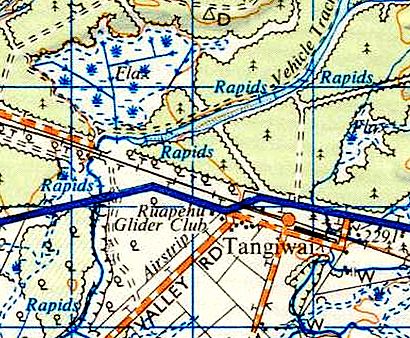Tangiwai railway station facts for kids
Quick facts for kids
Tangiwai railway station
|
|||||||||||
|---|---|---|---|---|---|---|---|---|---|---|---|

Tangiwai railway station on 1966 map
|
|||||||||||
| Location | New Zealand | ||||||||||
| Coordinates | 39°28′07″S 175°35′37″E / 39.468628°S 175.593744°E | ||||||||||
| Elevation | 700 m (2,300 ft) | ||||||||||
| Line(s) | North Island Main Trunk | ||||||||||
| Distance | Wellington 299.49 km (186.09 mi) | ||||||||||
| History | |||||||||||
| Opened | 12 August 1907 | ||||||||||
| Closed | goods 13 October 1986 passenger 26 November 1978 |
||||||||||
| Electrified | June 1988 | ||||||||||
| Previous names | Waitangi until 24 July 1910 | ||||||||||
| Services | |||||||||||
|
|||||||||||
Tangiwai was a railway station located in the Ruapehu District of New Zealand. It was part of the important North Island Main Trunk (NIMT) railway line. The station served the small community of Tangiwai. Today, nearby factories that make paper pulp and cut timber are a big part of the freight carried on the NIMT line.
In 1953, a terrible event known as the Tangiwai disaster happened near the station. A bridge over the Whangaehu River was swept away, causing a train accident. Tangiwai is also home to one of four special power stations that supply electricity to the NIMT's electric trains.
What's in a Name?
The station's name was changed to Tangiwai on July 24, 1910. Before that, it was called Waitangi. The Waitangi Stream flows just south of the station.
The Karioi Forest is very close to the station. This is why the nearby pulp mill is called Karioi. The next station further north-west was also named Karioi.
Station History
Engineers started planning the railway route in this area in 1894. By 1907, a temporary railway line was built to carry materials for the main track. This included a special pit near Waitangi that provided ballast, which is the crushed stone used under railway tracks. This ballast pit was used until 1946.
The railway line officially opened for goods trains from Waiouru to Rangataua on August 12, 1907. A station building was finished by March 1908. It had a waiting area, an office, and restrooms.
The station also had a goods shed for storing items and a loading area for trains. In 1910, the goods shed burned down, and the station building itself was damaged by fire in 1912. Houses for railway workers were built between 1904 and 1954.
The station had a "crossing loop," which is an extra track where trains could wait for others to pass. This loop was made longer over the years to hold more wagons. A Post Office operated at the station from 1913 to 1967. The station building was sold in 1971.
Important Bridges
East of the station, the Waitangi Stream is crossed by two bridges. To the west, the Whangaehu River is crossed by several bridges. All these bridges were built using strong metal beams called plate girders, which came from England.
Timber and Pulp Traffic
For many years, the Tangiwai station was important for moving timber. From 1908 to 1930, a sawmill owned by George Syme had its own small railway line connected to the station. This line helped transport timber to a factory in Hāwera.
In 1966, a new sawmill called Tangiwai Sawmill was built right next to the station. The station was very busy then, with three staff members working there all the time.
Later, in 1979, the Karioi Pulp Mill started making paper pulp. This mill, located about 3 kilometers north of the sawmill, used the railway from the very beginning. The pulp is packed into large bundles and loaded onto special railway wagons.
At first, the pulp was sent to ports in New Plymouth and Wellington. Since 2014, it has been sent to the port in Napier for export.
In 1970, special tracks were built at the station for the sawmill to load its timber. However, the station closed for all traffic in 1986. This meant that for a while, trucks had to carry the timber to Wellington. But thanks to a government grant, the timber is now back on the trains. It is added to the daily train that comes from the pulp mill.


